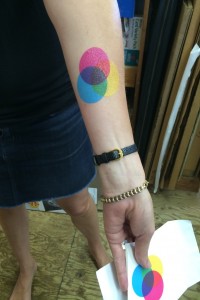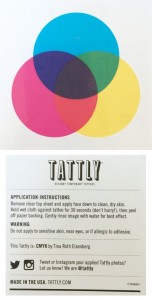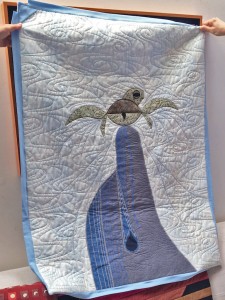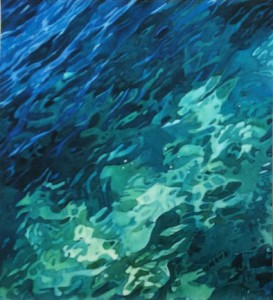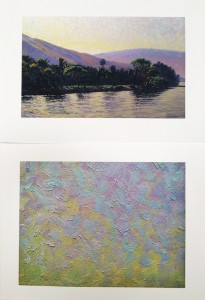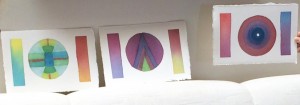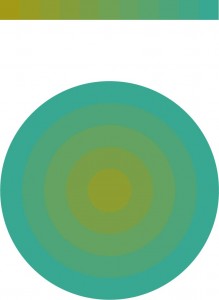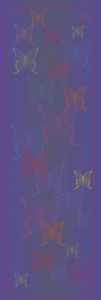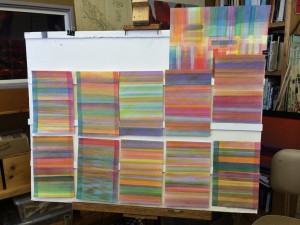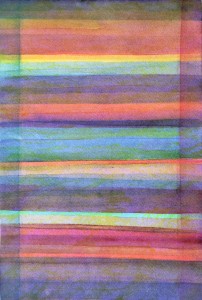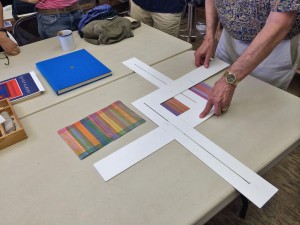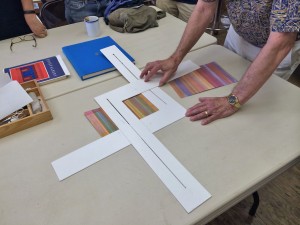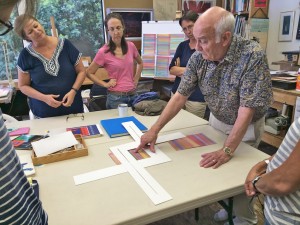The fifth session of the Color Relationships 1 class for Summer 2015 was held on Tuesday, August 25th. Our last session for the series was a visual delight, from viewing the range of materials and various interpretations of the homework, to our guest speaker Valérie sharing her recent watercolor explorations. We heard a philosophical take on Dick’s theory of teaching and the shared contract of responsibility in the student/teacher relationship, discussed the value of experimentation, and wrapped up with a delicious potluck lunch and a fun hour of socializing.
Class overview
Tattoos and Albers’ legacy
We started off with a surprise: one class member, Lisa, had found such inspiration from this series that she had gotten a brand new tattoo of CMYK color circles! After Dick recovered from his shock, she revealed it was actually a temporary tattoo by Tattly, a company that specializes in temporary tattoos created by designers and artists. While checking out their selection, she found the beautiful CMYK circles and brought one for every class member. It seemed a perfect graduating gift for such an eye-opening series! While these tattoos only last a few days, the knowledge gained in these sessions will be informing everyone’s work for years to come.
- Lisa’s brand-new tattoo!
- CMYK temporary tattoo fun
After that we introduced our guest speaker for the day, Valérie Richter, who would be presenting her recent watercolor studies that explore luminosity, color relationship, and Dick’s “tri-hue” method of mixing transparent color washes. Before beginning the critique, Dick went through Albers’ book again, pointing out some of the examples and discussing Albers’ influence on his students. Dick talked about the importance of learning to put the lessons together to create the most visually effective work, and finding a way to take what you’ve learned and apply it in new and insightful ways: “[Vanishing boundaries] was Albers’ assignment, and I don’t understand why he didn’t incorporate it into his own work. What we have done in the class has already gone far past what Albers achieved, and so what’s next? It’s his own saying, ‘Learning never ends.’”
When asked if Dick ever considered putting out his own book on color theory, he responded that his videos and his online materials are his contribution to the field. “I made a whole DVD on this, with all the lessons, the tutorials, everything … and it’s great, because you get the interactive aspect, you can hear my voice, and watch the animations; everything’s there. I understand that some people like books and they like turning the pages and all that, but this is the future, folks: technology. And if you don’t accept that, then you’re living in the past.” As Dick explained later in class, it is his goal to ensure that his students become independent thinkers. He does not want us to simply fall in step with what is already accepted, but to push beyond the current boundaries and keep moving forward. What revelations are out there yet to be discovered? We will never find out if we stay within our comfort zones.
Homework critique and examples of vanishing boundaries
We moved upstairs for our homework critique and discussion. Since this assignment allowed for a choice of media, it was exciting to see how students explored the theme of vanishing boundaries within a range of materials. It was a chance for some students to jump into experimenting with how they might integrate these lessons into their own work, which has been a question on many people’s minds. Understanding the concepts is one part of the teachings; figuring out how to apply them to your own work is another challenge entirely.
We started with the students who had brought in non-digital work.
Keri used fabrics and thread as her media of choice:
- Keri’s quilt of vanishing boundaries
- She also brought in a quilt she recently completed based on a Charley Harper design
Chelsea used pastels:
- An older work done in pastel
Tracy brought in acrylic paintings and photographs, and a few small studies she was playing with. She also brought in photographs of another artist’s work, and a close-up of the brushstrokes in the image:
- Another painting from the water series
- An example of another artist employing vanishing boundaries, with a close up of the brushwork
Elizabeth Ann brought a few watercolors studies, and a book (seen on the couch) by another watercolor artist, Mark Adams, as an example of work that inspires her:
Then we viewed the digital examples.
Lisa’s work:
Gail’s work:

Patty’s work:
 Debra submitted different images which demonstrated her process in approaching the assignment, and also how she might apply the lessons to her own work:
Debra submitted different images which demonstrated her process in approaching the assignment, and also how she might apply the lessons to her own work:
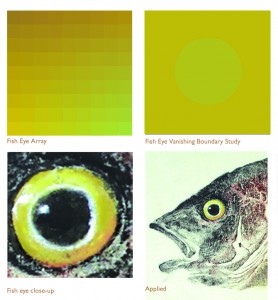 Suchi’s work, along with a photograph that she enhanced in Photoshop and used as inspiration for the landscape rendering:
Suchi’s work, along with a photograph that she enhanced in Photoshop and used as inspiration for the landscape rendering:
Stephanie’s work, showing how she used one matrix to create two very different compositions:
The goal of the teacher-student relationship
Stephanie also mentioned her appreciation for Dick’s commitment to teaching, which she experienced after she had submitted her initial study. Dick had given her feedback, which at first she felt was a reprimand that she had done something ‘wrong’, but on further reflection realized Dick was communicating that he had not done his job as a teacher. This led to a brief reflection by Dick on the role of the teacher, and the ‘contract’ that is the teacher-student relationship.
“Well, I don’t do you a service at all by giving false praise. My whole mission is to go from a ‘pretty controlled parent’ to ‘total freedom’, and a lot of art teachers like to say ‘Do your thing, man, do your thing.’ No, I don’t agree with that: it’s like asking a baby to survive on its own. The baby is going to die if you don’t feed it, you don’t clothe it; but you also don’t want that baby at 30 years of age living at home and being dependent on you. I believe in taking a student from dependency to independent; and if we, as teachers, make them more dependent on us, then we haven’t done our job. You can’t grade something you can’t teach. You can only measure by what our task was, and so this is a contract, where I’m going to teach you color, and what is your responsibility? And if you don’t do it, then it’s my job to make sure I’m getting through to you.”
He summed up the success of the class by congratulating them on how well they came through on these assignments: “I can’t tell you how much it means when I see how far we’ve come, especially in this last week. It is just so exciting to realize that you can achieve this level of work – ’cause you can’t fake this, and you either get it or you don’t.”
Valérie’s watercolor studies and the importance of cropping
After our coffee break, we were treated to Valérie’s recent undertaking, a commitment to studying color. She is practicing with watercolors, and as a transparent media, they can be very useful in creating color harmony. Dick talked about how one of the obstacles in our way is usually the desire to create something “perfect” or something that we are too attached to: “So often when we get engaged with subject matter, we don’t see what is happening with color and shape … She was at a point where she needed to stop making ‘precious stones’ and start making “stepping stones” to expand her vocabulary in color, and then go back to what she was doing.”
Valérie spoke about her process, the way she layers colors, and spoke about some of the revelations she has had that are changing the way she thinks about and approaches her work. “If you want to learn about colors, you have to drop completely painting ‘something’: just work with colors. And once awhile I think, ‘I’m going to try to do the ocean.’ So I was layering the colors, and I got stuck, and you get stuck because you’re trying to fit into this little thing, instead of having the freedom to just play with all those colors. So when I saw that I was stuck, I threw away the picture, and I thought ‘Just play with it, be bold, and go for it! It’s not precious, and you’re going to mess it up.’ So every time you learn a little something. But you have to let go.”
Her revelations are mental adjustments, or, as Dick would describe them, behavioral changes. As she works with the colors, she is learning all the time, and learning to let the process happen naturally. “You also have to try to focus on one thing at a time, because there are so many: between the harmony, the toning, the vanishing boundaries, the halations – you can’t try to do it all at once. So focus on one aspect at a time, and little by little … But it just takes putting in the hours. You start seeing it when it’s right, like values: before, I thought I had to learn values, and work at it, but as you do it, as you paint, it just comes to your eyes.”
Dick brought out his white ‘L’ guides and demonstrated the value of cropping. “When we do something like these studies, the cropping is very much a part of it, because we are not creating a composition, we are doing studies. These are not works of art, they are more ‘what would happen if?’ So I want to put a couple down and go over them with the cropping tools, and show you how you can hit on a particular color theme or an idea for a piece.” Dick likes to refer to it as the ‘cuisine’ of a piece, similar to a tasty entrée where the chef blends a multitude of flavors, yet keeps the dish balanced. It is about looking at the Gestalt, the play of interaction, and finding the right balance that allows “all voices in the choir to be heard”.
We finished off the class with a couple short segments of video, one from the introduction to the Albers’ app, and another from the juror for the Art Maui 2015 show, to show again the danger of listening to so-called ‘experts’ without questioning their reasoning and using our own intelligence. Then it was time to eat, to mingle, and wrap up another successful graduation of “Color Snobs”!
